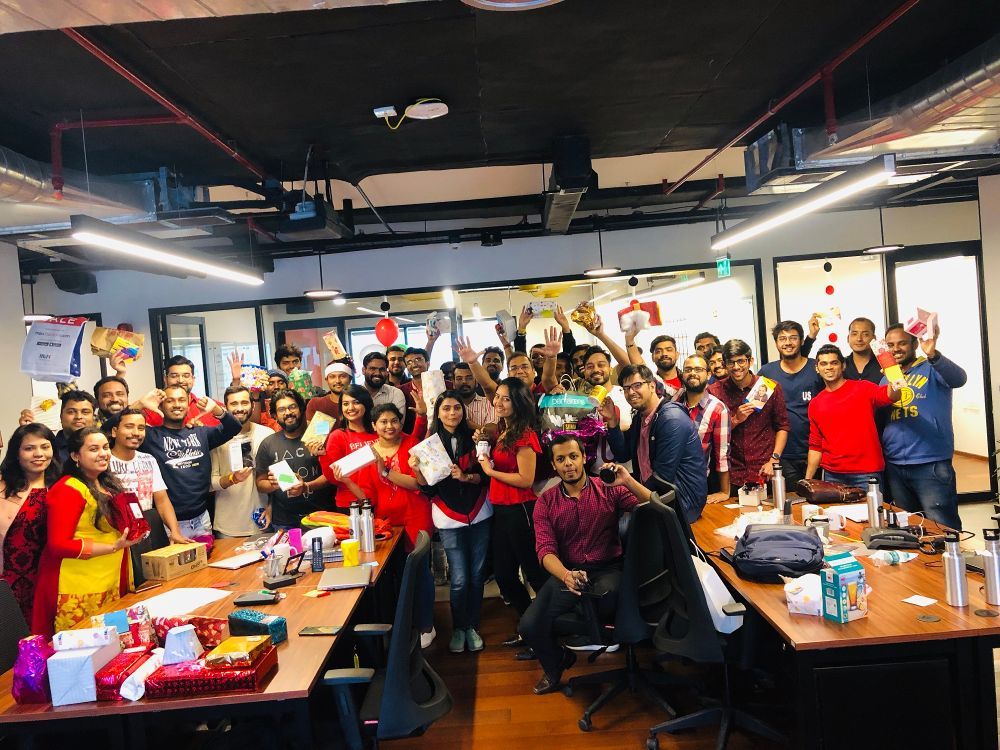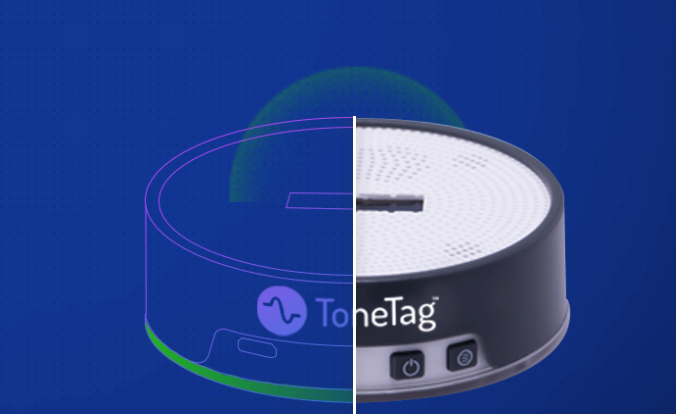In India, it isn’t uncommon to receive candy in lieu of small change at small retail outlets. This practice was something Kumar Abhishek, who had returned from Singapore in 2013, never understood.
He had worked for multinationals such as IBM, MindTree, and Infosys, where he got a chance to work at their offshore offices in Europe and the US. During his tenure there, Kumar had already seen the explosion of cashless transactions and mobile wallets. He observed their payment systems and financial infrastructures and then compared them with the then-existing financial and banking systems of India.
To change the scenario in India, Kumar, along with Vivek Singh, founded Tonetag.
The duo developed technology that used soundwaves to enable data transfer between two devices, such as feature phones and carry out digital payments.
As of April 2021, ToneTag claimed to have served about 100 million customers through consumer applications and has powered over 1.3 lakh electronic data capture devices, 1.5 lakh mobile PoS, and 4,000 computer PoS systems.

ALSO READ

[Product Roadmap] How gaming startup Playerzpot evolved from an app that crashed during IPL 2018 to touch 5M users
Making digital transactions simple
Alongside UPI, online payment options, and wallets, ToneTag continues to address a core problem. Reports suggest that over 770 million people in India still don’t have access to web services. Lower-tier cities and rural areas account for a majority of the population without access to internet services, mostly because of a lack of infrastructure.
ToneTag addresses another core issue as over two-thirds of the population do not own a smartphone and relies on a feature phone, making it difficult for fintech companies to extend their services to them.
“Our technology establishes secure connections for D2D and D2C interactions through audio waves. The software algorithm (SDK) encodes data into sound waves, which can be transmitted between devices,” explains Vivek.
ToneTag only requires the integration of its proprietary SDK on the merchant (EDC, PoS, phone) and customer (mobile banking, wallet, payment apps) side. With this, the company is able to solve the challenge of onboarding people residing in areas of poor internet connectivity and low digital literacy onto digital payment platforms, especially in rural India.
“Our solutions are engineered to ensure efficiency and safety but also deliver an experience that is seamless, and most importantly, uncomplicated. Our ultimate goal is to improve India’s digital financial inclusion by enabling digital payments for all citizens irrespective of their geographic location or network availability,” Vivek tells YourStory.
ALSO READ

[Product Roadmap] How edtech startup Toppr built tech to personalise learning for students
Increasing digital literacy
“Keeping our end goal in mind, we engineered solutions that are, first and foremost, easy to use – a user can make a digital transaction by simply speaking into their mobile, and, secondly – secure. The ToneTag tech embedded inside the phone recognises the user, identifies the command, interprets and executes it without any hassle. There are no complex pathways that require OTP and QR scanning; all the user has to do is speak into their device and get the job done,” explains Vivek.
Besides, they tackled low internet connectivity issues with their Feature Phone solution, through which a user can make the payment by dialling an IVR number and, simultaneously, the merchant PoS plays a unique tone that the software embedded in the phone recognises.
Vivek adds that the technology is built to bridge the last-mile connectivity in financial inclusion by enabling all mobile phone users to make simple cashless payments.
ALSO READ

[Product Roadmap] With easy-to-use models, how neobank Kaleidofin aims to address the needs of over 600M unbanked Indians
Deployment based on sector needs
An innovation-first company, ToneTag’s team built patented technologies that were used by banking and retail partners to execute secure and smooth payments.
Vivek explains the team has carefully tailored their products based on the challenges in the respective markets, especially considered the fact that the pandemic has changed the rules and the requirements across sectors.
“Therefore, we not only had to engineer our products based on the internal challenges of a sector but also take into account the external factors caused by the pandemic,” says Vivek
Taking the hospitality and retail sector as an example, Vivek says both of these were hit by the pandemic, and neither seemed to have an appropriate response to this new development.
Addressing the retail need
“The number of restaurants and food outlets that shut easily dwarfed the number of retail outlets that went out of business,” adds Vivek.
He adds the solutions for retail-focused mainly on getting the customer back in touch with the retailers and stressing the safety issue.
The team enabled offline retailers and small merchants to take their businesses online, wherein their customers can place groceries orders online and have them delivered to their doorstep, or optionally arrange a self pick-up, where the customer can place an online order and later visit the retail store to pick up their order, which is packed and ready to go.
Secondly, they enabled the customer to make contactless payments inside the retail store. The customer can enter the store, shop for their groceries, get a digital bill, then pay using their voice, and exit the store without having to stand in line or face the counter crowd.
Simultaneously, ToneTag has also embedded smart solutions in the retail store infrastructure that has helped merchants in automation and product tracking. The store is digitised, operations are automated, and the merchant can monitor their store activities – all on one platform.
“This has not only eliminated operational inefficiencies but also greatly improved store management,” Vivek adds.
ALSO READ

[Product Roadmap] How CASHe used proprietary tech and credit writing systems to disburse Rs 2,500 Cr in loans
The hospitality need
For the hospitality sector, they focused on people feeling safe and confident about dining in a restaurant as that was a major revenue source. The most effective way to encourage dining at the restaurant was to reduce surface touching and promote automation.
“Under our QSR and smart dining solutions, we embedded the restaurant with our digital waiter – a compact and interactive piece of hardware that sits on the restaurant table and wakes up upon the arrival of a customer. The digital waiter displays the menu on the customer’s phone and subsequently takes the order. It then relays it to the kitchen and keeps the customer informed about their order preparation. Upon completion of the meal, the digital waiter produces a digital bill on the customer’s phone and accepts payments too,” explains Vivek.
The solutions also allow customers to order ahead of time. Then, upon arrival, the customer can simply walk into the restaurant, pick up the order, and leave.
“We wanted to build a product that caters to a universal customer base and so our solutions needed to be (a) compatible with existing infrastructure (b) interoperable between devices of different configurations (c) secure (d) capable of providing data in real-time,” says Vivek.
ALSO READ

[Product Roadmap] How SaaS startup Dukaan used tech and customer feedback to go from zero to 3M merchants
Adding the engineering layers
The most important factor for the team was to build a product that would merge into the existing infrastructure and not require any additional hardware or software entities. This was key to scaling as it becomes enormously easier for both merchants and customers to adopt a technology that they can use on their existing devices without any hassle.
Then, closely linked to compatibility was the feature of interoperability that ensured connections between devices were seamless and as easily established as possible. Possibly the most important aspect of any financial solution is safety and security.
“To this end, we engineered a three-layered encryption technique to ensure state of the art security for transactions. These were the core features that we wanted to be kept consistent and then went about adding layers over it to develop new and more advanced products and solutions,” explains Vivek.
All of ToneTag products use audio-based technology that is highly compatible, scalable, and interoperable.
“Our tech also gives us leverage to engineer our products as per customer requirements, and of course, the feedback we receive from our partners and customers is crucial in determining the direction of the development of the products. It follows the classic model, where the first Beta is made and subsequently upgrades and alternations are done,” adds Vivek.
ToneTag is one of the few firms that are capable of manufacturing audio-based software and solutions. This also means that there are a limited number of people who are skilled in audio-based solution development.
ALSO READ

[Product Roadmap] How CashFlo is using tech to meet the credit needs of more than 50,000 SMEs
Catering to multiple segments
Most people are apprehensive about adopting any new technology, especially if it involved money transfer. This required the team to keep going back to the drawing board until they came up with a product that was exactly what the customer and partners understood and loved.
Today, ToneTag caters to multiple segments:
The retail pod: It is a robust and low-cost payment acceptance device that enables contactless and digital payments. It is a digital cashier that is placed at the store’s cash counter to automate and digitise all payment acceptance tasks. The Pod establishes a secure connection with the payer’s device through sound waves and completes the transactions.
Peer-to-peer payment: A smart and secure proximity-based payment method where a user can transfer money to another user through ToneTag technology. The only requisite is that both the recipient and the payer must be within proximity, around six feet.
Order ahead: As a part of QSR, restaurant, and groceries solutions, ToneTag has developed the Order Ahead feature for its users. Using ToneTag tech, a user can place a takeaway order at a restaurant before arriving at the restaurant.
Digital Waiter: A smart and interactive dine-in solution that makes food ordering and bill payments completely digital. As the name suggests, the digital waiter caters to all the dining needs of the users – from displaying the menu on the user’s phone to taking the order, producing the digital bill, and accepting contactless payments.
Feature Phone: ToneTag technology has enabled digital payments on basic Feature Phones in areas with low or no internet connectivity. A user can make the payment by dialling an IVR number and, simultaneously, the merchant PoS plays a unique tone that the software embedded in the phone recognises.
SonicEngage: Built as an effective marketing tool, SonicEngage integrates with a brand’s marketing communication (video/post/radio spot) making it more interactive and engaging. Once SonicEngage is embedded into a brand communication, it enables the customer to purchase the product while watching/listening to its ad on TV/radio. This vastly increases sales and allows brands to navigate the customer from its ad to its product purchase page.
Market and future
The startup’s competitors in the sound-based proximity data transfer space include UltraCash, Trillbit, and California-based LISNR, among several others.
But, with the digital payments space in India set to rise fivefold to $1 trillion by 2023 and a huge regulatory push for more solutions and innovation in offline or internet-free payments space, ToneTag, and others like it, are expected to see huge growth opportunities in the coming years.
“Currently, we are enabling an acoustic-data driven platform for completely hands-free commerce and voice-based interactions. Our efforts are directed towards taking this audio-based technology mainstream and creating an ecosystem where all digital interactions such as payments, ordering, shopping, and even withdrawing money at an ATM is carried out by our audio-based technology,” says Vivek.
Edited by Kanishk Singh
Read more: yourstory.com
